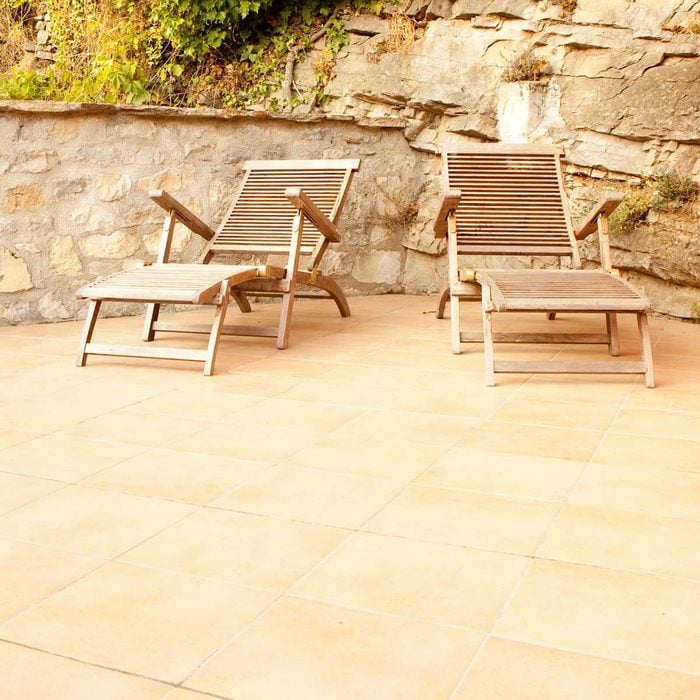Porcelain vs. Ceramic Outdoor Tile: What’s the Difference?

Thinking of tiling your deck or patio? Let's compare your options, porcelain and ceramic, so you can make the best choice for your project.
At first glance, ceramic and porcelain tiles look and feel similar. It’s easy to find many examples of each in home centers and tile stores. But the history of one dates back at least 5,500 years earlier than the other.
The earliest version of ceramic tiles that we know of comes from ancient Egypt, where simple, bluish glazed bricks were used to decorate houses. Porcelain tiles didn’t come on the scene until much later, in Chinese towers around the 15th century A.D. Today, porcelain and ceramic tiles are commonplace, often installed on outdoor surfaces like decks and patios. Learn about these two tile types and how they perform outdoors.
On This Page
Porcelain and Ceramic Tile: The Basics
Porcelain and ceramic tiles can both be used for outdoor surfaces like decks and patios. They’re both hard, reasonably durable flooring materials made of clay molded into thin sheets, then dried in a kiln.
The differences come down to composition and manufacturing. Porcelain tiles are made of a finer, more refined clay. As they’re formed, porcelain tile clay is pressed harder into its desired shape, leading to denser, heavier tiles than the ceramic variety. Porcelain tiles are also fired at higher kiln temperatures, leading to harder, stronger and more scratch-resistant tiles.
Ceramic tiles are less dense and more porous. They can be glazed for increased sheen and protection, or remain unglazed for a rougher, more natural feel. Their density, compared to porcelain tiles, makes them less water and stain resistant, particularly if they’re unglazed.
Pros and Cons of Porcelain Tile Outdoors
Pros:
- More durable than ceramic tiles due to their increased density;
- Tougher and more scratch resistant that ceramic tiles;
- Less vulnerable to water and other liquids;
- Easier to clean than ceramic.
Cons:
- More expensive, costing from $5 to $10 per square foot, with some specialty tiles as expensive as $30 per square foot or more;
- Heavier and harder to cut and work with than ceramic, making installation tougher. Cutting porcelain tiles requires special tools, making the process tougher for DIYers.
Pros and Cons of Ceramic Tile Outdoors
Pros:
- Less expensive than porcelain tiles, averaging from $1 to $8 per square foot;
- Lighter and easier to cut and install than porcelain tiles;
- Wider range of colors and styles available.
Cons:
- More crack-prone than porcelain tiles;
- Less wear resistant than porcelain, making them vulnerable to heavy traffic in an outdoor setting where sand, gravel and dirt will get underfoot;
- More porous, making them more vulnerable to water seeping through, and to dirt staining.
How to Make the Best Choice for Your Deck or Patio
If your deck or patio draws lots of heavy traffic and you want it to last as long as possible, choose porcelain tiles. If you’re interested in a less refined, more natural feel and prefer to minimize costs, go with unglazed ceramic tiles for your patio. Glazed ceramics can give you more color and design options, so choose these if you’re looking for a bright, eye-catching deck or patio.
Note: Installation Considerations
Whether you choose porcelain or ceramic tiles, take note of the integrity of the surface you plan to tile. Unless you use a tile uncoupling membrane prior to laying down your thinset mortar and tiles, your sub-floor needs to be rock solid and well-supported so it won’t flex when people walk on it.
The surface under the tile also needs to be relatively free of expansion and contraction. Even with an uncoupling membrane, the movement tolerance of a tiled surface is low. Sub-floor flexing or annual expansion and contraction can cause your tiled deck or patio to crack along the grout lines. That’s why if you’re tiling a deck, your joists must be extra wide and beefy, with a least one layer of 3/4-in. pressure treated plywood on top. Two layers is better.
If you’re tiling a patio, pour your concrete pad thick and strong enough to avoid cracking as the earth shifts beneath it. Make it five inches thick at a minimum, and reinforce with rebar.


